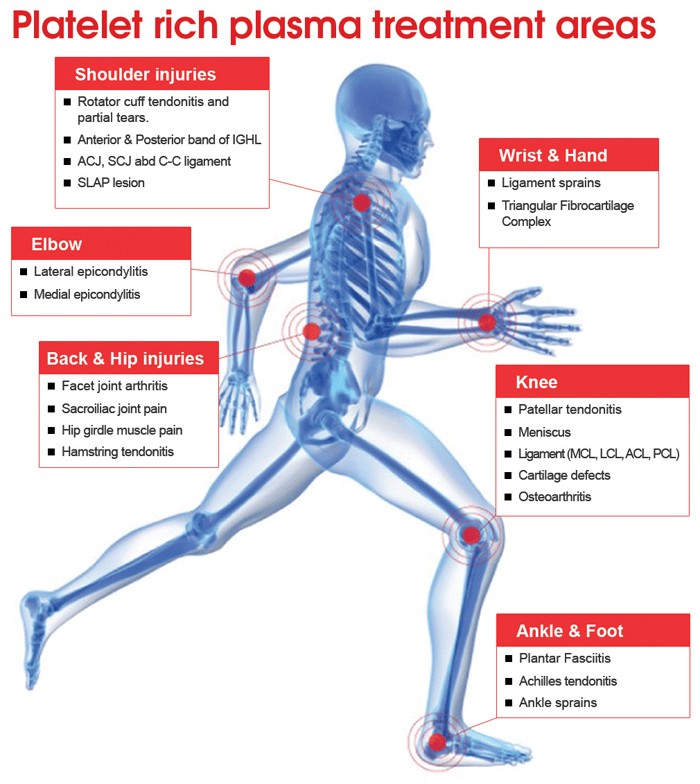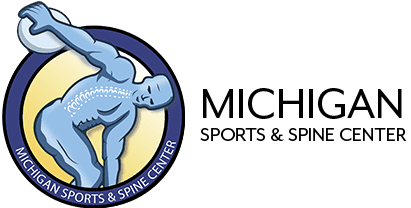Why Get PRP Treatment?

Learn How PRP Therapy Could Help You
Chronic overuse and traumatic injuries from sports are common but often difficult to treat. Tissue repair may occur too slowly for athletes who are looking for a fast, complete recovery as soon as possible. The healing process is complex, involving bioactive proteins and other elements that stimulate cellular growth, also known as growth factors.
Platelet Rich Plasma (PRP) treatment was developed to enable patients to produce these growth factors at an accelerated rate. Using the patient’s own blood, PRP injections provide a concentrated dosage of the elements needed to promote tissue repair.
PRP treatment involves isolating one element of the blood for injection into the site of injury. To understand how it works, it’s important to know the difference between plasma and platelets, as our goal is to get Platelet Rich Plasma for this procedure.
What Is Plasma?
Plasma refers to the liquid aspect of the blood, which carries red and white blood cells. Though plasma is mainly water, it also contains proteins, glucose, nutrients, and antibodies.
What Are Platelets?
Platelets are a normal part of the blood, like red and white blood cells. While they do not have restorative properties by themselves, platelets do secrete the growth factors involved in cell division, tissue regeneration, and healing. Platelets also help with blood clotting to prevent excessive bleeding.
The Procedure
A platelet-rich plasma injection can be done at some doctor’s offices, however, we perform our procedures at a surgical center, to ensure safety protocols and proper injection procedures are in place. The entire process requires less than 30 minutes to draw the blood, spin it down in the centrifuge, and inject it into the specific injury site.

It can be challenging to find a physician that offers this treatment, though it is more commonly provided by Sports Medicine doctors. Dr. Jeff S. Pierce, PM&R Specialist, has been a thought leader on these cutting-edge treatment options offered from Regenerative Medicine techniques such as PRP Therapy.
Michigan Sports and Spine Center offers PRP treatment for a variety of conditions, including cartilage and joint injuries, osteoarthritis, and some tendon injuries. These injections can stimulate healing and relieve pain. Ask Dr. Pierce if PRP treatment is appropriate for you. He is currently offering ONLINE CONSULTATIONS for PRP and/or Stem Cell Treatments- Book Today!
How Is Platelet-Rich Plasma Obtained?
Though it may sound like a complex process, it is actually quite simple. Blood is withdrawn from the iliac crest in your hip and placed in a centrifuge, a special machine that spins at a high speed to separate the blood cells. The doctor extracts the platelet portion of the blood and injects it into the area of injury.
How Is It Injected?
The PRP injection takes place as soon as the blood has been spun and separated into platelets and plasma. Studies have shown that the tendons can also activate the PRP, making an activating agent unnecessary in some cases. Depending on the nature of the injury and your physician’s approach, you may receive one injection or several over a span of months.
Dr. Pierce uses an analogy to explain the difference and coinciding effects of Platelet Rich Plasma Therapy combined with Stem Cell Therapy:

Let’s compare this to your lawn maintenance. You aerate the grass and create holes in it to drop the seeds in. The “seed” is considered the Stem Cell. In this case, the “fertilizer” is the PRP Therapy. Ideally, you want to do both the PRP and the Stem Cell Therapy in the beginning, fertilizing the seed with the PRP. However, like your lawn, you can first “seed” it with Stem Cell, and then 3 months later, when you want your lawn to look even better, you do not have reseed it, but instead just fertilize it. In other words, you do not go back and reseed the lawn or redo the Stem Cell Therapy; Instead, you just “fertilize” it with PRP Therapy.
What Injuries Benefit from PRP Treatment?
The research has suggested that PRP therapy is more effective for treating some injuries than others. At Michigan Sports and Spine Center, we have found a lot of success with PRP Therapy in all of the joints, including the spine. Here are a few examples of treatment areas, as well as a testimonial from Darren McCarty on his experience with Regenerative Medicine at Michigan Sports & Spine Center.

- Spine
- Shoulder injuries (Darren McCarty)
- Tennis elbow (elbow tendonitis)
- Jumper’s knee (patellar tendonitis)
- Acute muscle tears
- Mild diffuse cartilage injuries
- Osteoarthritis
What Does the Research Say?
While PRP is not covered by all medical insurers, the growing body of research continues to emphasize the benefits in its ability to treat tendon and joint conditions.
- (1) “Platelet-Rich Plasma Versus Hyaluronic Acid for Knee Osteoarthritis: A Systematic Review and Meta-analysis of Randomized Controlled Trials“
- This review of studies showed that patients with knee arthritis who undergo PRP injections have statistically significant improvement in symptoms compared to those receiving traditional treatment methods.
- This study found that when comparing PRP & stem cell injections to steroid injections for tennis elbow (lateral epicondylitis), those who have regenerative therapies have longer-term pain relief and improved function.
- (3) One of the largest studies examining PRP treatment involved 230 patients with tennis elbow, with each group receiving either PRP or traditional treatment.
- This study compared PRP vs. active needling therapy (which is a typical treatment strategy in a non-regenerative practice). It showed that PRP was significantly more beneficial than typical needling therapy.
- Findings: “After 24 weeks, 84% of those receiving PRP treatment noted significant benefit which was statistically more significant than those receiving traditional therapy. Additionally, at 24 weeks, only 29% had pain after PRP therapy compared to over half of those who received traditional therapy.”
Seek PRP Treatment at Michigan Sports and Spine Center
PRP may be an option to consider for a variety of patients considering a wide range of injuries and conditions. Dr. Jeff S. Pierce has been thoroughly trained and utilizes the best, most appropriate and sometimes aggressive treatments when caring for patients with sports, occupational, or auto injuries.
At Michigan Sports and Spine Center, we ensure that each patient benefits from a comprehensive treatment plan that treats the ROOT cause of the orthopaedic condition, NOT masking it with unnecessary medications. In other words, we aim to facilitate healing in the most effective manner possible.
*To consult with one of our specialists about PRP or other treatments, please contact us at (248)426-9944 or visit us here to learn more.
